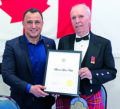Columns » Opinion
FRONT PORCH PERSPECTIVE: Statistics that sing
August 17, 2018 · 0 Comments
By Stephen Somerville
When a new administration takes over invariably it seems the first thing they do is claim that the government cupboard is bare. It really is a tried and true tradition. By doing this, it provides the new government with a cloak for any harsh economic measures they may want to implement and it gives them the added bonus of blaming the current fiscal woes on the rascals that they just replaced.
The Auditor General of Ontario office does publish an economic statement just prior to every election.
And the one they published in April of this year spanked the governing Liberals hard. The report concluded that the “Pre-Election Report is not a reasonable presentation of Ontario’s finances insofar as its expense estimates are understated for two items resulting in understated annual deficits.”
These statistics certainly don’t tell the whole story, but they are the basis upon which to begin the debate about priorities and the fiscal capacity to implement a proposed legislative agenda. Furthermore, the incumbent party would have a tougher time disguising any fiscal shenanigans.
The report goes to on to state, quite clearly and succinctly:
“When expenses are understated, the perception is created that government has more money available than it actually does. Government decision-makers might therefore budget more money to be spent on initiatives and programs, when that money is actually needed to pay for expenses the government has failed to record properly. Therefore, more money will need to be borrowed to pay for the unrecorded expenses even when government reports an annual surplus or a balanced budget. A perception is also created of an improving trend in the relationship between the government’s financial obligations and its capacity to raise funds to meet them, when the burden of net debt is actually increasing.”
We need a similar, but slightly different document in Aurora.
I know that a number of years ago, as part of the Aurora Strategic planning process, a review of community attitudes surveys were completed. At the time, eighty-five percent of those surveyed believe that the quality of life in Aurora is good to very good. But thirty-eight percent feel that the Town was changing for the worse and thirty-eight percent feel that the Town was changing for the better.
The results showed that we love our Town but we are also very confused and concerned about the future of our community.
I will bet that these numbers are similar today and if so, it means that the municipal election this fall is very important.
Some type of document is needed that provides the voters with unbiased and unvarnished basic information.
It would be nice if the good folks at the Aurora Town Hall produced such a document. But it would be even better if our fellow citizens published this information,
A group of concerned citizens and stakeholder groups could, together, either purchase say a couple of pages of ads in this newspaper or produce a brief pamphlet which could be inserted into The Auroran.
Such a group could include the Aurora Chamber of Commerce, various rate-payer associations, volunteer organizations and the three main provincial political parties.
This committee could be comprised of ten to fifteen citizens who are not supporting any of the mayoralty candidates. They would hold a couple of meetings this summer and decide upon the important metrics that should be included in this voter handout.
The document should have a number of easy to read charts and graphs, with not a lot of text. The graphs would show five-year trend lines for a number of various metrics.
The trends would also show how we compare against other similarly sized communities. It should also include comparisons against Newmarket. Although Newmarket has a much larger population than Aurora, there is a commonality, based on proximity, community make-up and shared interests.
Visually, it could be something akin to the community events calendar that is published on a regular basis in this newspaper. The calendar is a cornucopia of information, and is visually appealing and easy to go through. Something similar would be nice.
As the municipal election takes place on October 22, the document should be published in late September, just prior to the various public hall and debate forums.
Hopefully, such a document would serve as the jumping off point for people to ask questions about the issues of growth, the level, quality and costs of services, and the appropriate level of taxation.
Managing growth while maintaining Aurora’s unique “small town feel” is an important issue. Transportation infrastructure and transportation congestion is another. Public safety and security concerns as population increases is still another.
Other items to debate during the fall campaign include the appropriate level of taxation to assist in managing growth challenges. High incomes and land costs make it difficult for a wide range of incomes to settle in Aurora. Sources of funding for capital projects, service and program delivery when the Town is built out (i.e. loss of development charges). The list goes on.
Stable neighbourhoods has also become a big issue. Residents want to hear from the prospective mayoralty candidates about what improvements or changes they would like to see to the Town’s Zoning By-law in order to protect the character of our existing neighbourhoods.
We are all aware that the lowest voter turnout occurs for municipal elections.
Any measure that can be utilized to both further educate and interest our fellow citizens in voting should be explored.
Stephen can be contacted at stephengsomerville@yahoo.com











